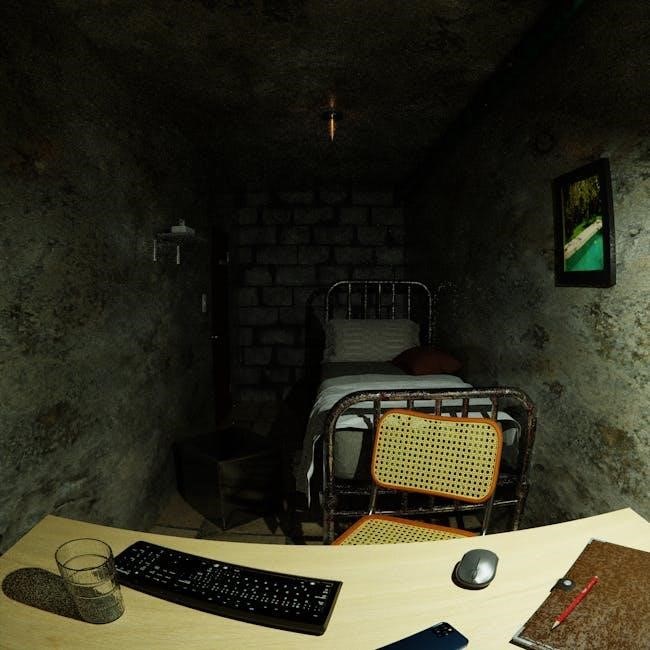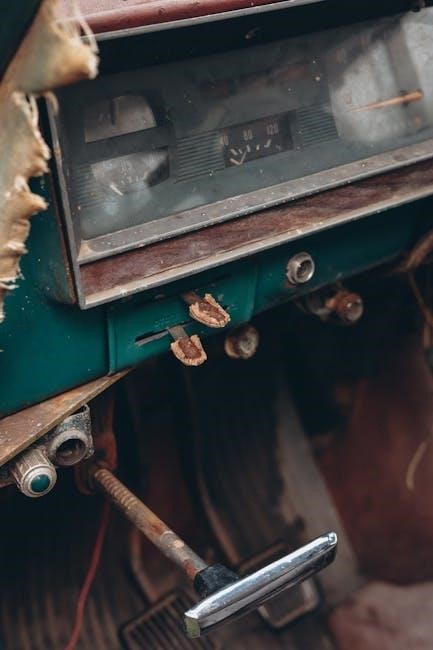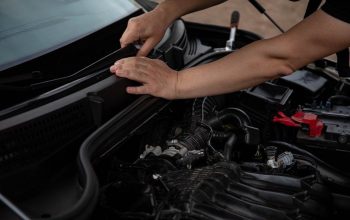Welcome to your sunroof manual! This guide provides essential information to help you understand, install, maintain, and troubleshoot your sunroof system effectively for optimal performance and safety․
1․1 What is a Sunroof Manual?
A sunroof manual is a comprehensive guide designed to provide detailed instructions and information about the installation, maintenance, and operation of a sunroof system․ It serves as a detailed resource for understanding how to properly use, care for, and troubleshoot your sunroof․ This manual is tailored for both professionals and car owners, ensuring that everyone can optimize their sunroof’s performance and safety․ By following the manual, users can prevent damage, ensure longevity, and enjoy the full benefits of their sunroof system․ It also includes safety guidelines to avoid accidents and ensure proper functionality․
1․2 Importance of a Sunroof Manual
A sunroof manual is essential for understanding proper installation, maintenance, and troubleshooting․ It ensures safety, optimal performance, and longevity of your sunroof system․ By following the guide, you can avoid costly repairs, maintain functionality, and enjoy your sunroof’s features confidently․ Regular maintenance and correct operation, as outlined in the manual, prevent damage and extend the system’s lifespan․ It also serves as a troubleshooting resource, helping you address common issues quickly․ A well-maintained sunroof enhances your driving experience and vehicle value․
1․3 Key Features of a Sunroof Manual
A comprehensive sunroof manual typically includes detailed installation guides, maintenance schedules, troubleshooting tips, and safety precautions․ It also features diagrams, warranty information, and repair instructions․ The manual ensures users understand operational limits, lubrication needs, and seasonal care․ Additionally, it covers emergency procedures and provides contact details for professional assistance․ These features make it an indispensable resource for optimal sunroof functionality and longevity, ensuring both performance and safety are prioritized․

Understanding Sunroof Components
Your sunroof system consists of several key components that work together to provide functionality and durability․ Understanding these parts ensures proper operation and maintenance of your sunroof․
- Glass panel for natural light
- Shade for light control
- Motor and gears for movement
- Control mechanism for user input
2․1 Overview of Sunroof Parts
Your sunroof system consists of several key components designed to work together seamlessly․ The primary parts include the glass panel, which allows natural light and fresh air into your vehicle, and the shade, which helps regulate light and temperature․ Additionally, the motor and gear system power the opening and closing mechanisms, while the control mechanism, typically a button or switch, enables user operation․ Understanding these components is essential for proper installation, maintenance, and troubleshooting, ensuring your sunroof functions efficiently and reliably over time․
2․2 The Glass Panel
The glass panel is a critical component of your sunroof, designed to provide natural light and ventilation while maintaining structural integrity․ Typically made of tempered or laminated glass, it ensures safety in case of breakage․ The panel is framed securely within the sunroof assembly and sealed to prevent water ingress․ It also features UV protection to reduce heat and glare․ Regular maintenance, such as cleaning and inspecting for cracks, is essential to preserve its clarity and durability․ Always handle the glass panel with care to avoid damage․
2․3 The Shade
The shade is a crucial component of your sunroof system, designed to block sunlight and reduce heat entry into the vehicle․ Typically made of durable fabric or vinyl, it glides smoothly between open and closed positions․ The shade is usually operated manually or automatically, depending on your sunroof type․ Proper maintenance ensures it moves effortlessly, providing shade and comfort․ Over time, the shade may wear out and require replacement to maintain its functionality and aesthetic appeal․
2․4 The Motor and Gear System
The motor and gear system is the heart of your sunroof, enabling smooth opening and closing operations․ The motor drives a series of gears that synchronize the movement of the glass panel and shade․ Proper lubrication is essential to ensure quiet and efficient functionality․ Over time, wear and tear can cause gears to degrade, leading to operational issues․ Regular inspections and maintenance are crucial to prevent premature failure and ensure the system continues to perform reliably․
2․5 The Control Mechanism

The control mechanism is the interface through which you operate the sunroof; It typically consists of buttons, switches, or a touchscreen, allowing you to open, close, tilt, or slide the glass panel․ Modern systems often feature automatic modes, such as one-touch operation, for convenience․ Some controls include LED indicators to show the sunroof’s current position․ Proper use of the control mechanism ensures smooth operation and prevents damage․ Always refer to your manual for specific instructions on using your vehicle’s control system effectively and safely․

Installation Guide
Your sunroof installation guide offers a comprehensive walkthrough, ensuring a seamless setup process․ From tools preparation to final adjustments, this section covers everything needed for a smooth, safe installation․
3․1 Pre-Installation Checklist
Before installing your sunroof, ensure the following:
- Measure the roof opening accurately to confirm compatibility with the sunroof size․
- Verify all components are included in the installation kit․
- Inspect the roof for any existing damage or obstructions․
- Consult the vehicle’s manual to ensure no electrical or structural conflicts․
- Gather necessary tools and safety equipment․
- Ensure proper ventilation to prevent dust and debris buildup․
- Mark the installation area clearly for alignment accuracy․
- Double-check local regulations for any specific requirements․
Addressing these steps ensures a smooth and safe installation process․
3․2 Step-by-Step Installation Process
Begin by gathering all tools and materials․ Mark the roof area according to the manual’s measurements․ Cut the opening carefully using a saw or drill․ Install the sunroof frame, ensuring it is securely fastened․ Attach the motor and gear system, connecting it to the control mechanism; Place the glass panel into the frame, aligning it properly․ Secure the panel with adhesive or screws․ Connect electrical wires to the vehicle’s system․ Test the sunroof’s operation to ensure smooth movement․ Finally, inspect all connections and seals for tightness and functionality․
3․3 Manual vs․ Automatic Sunroof Installation
Manual and automatic sunroof installations differ in complexity and requirements․ Manual installation involves physical operation of the sunroof, requiring precise alignment and mechanical skill․ Automatic installation relies on motorized systems, offering convenience but needing specific tools․ Manual systems are often more cost-effective and easier to maintain, while automatic systems provide ease of use and faster operation․ Choosing between the two depends on your preference for control versus convenience․
3․4 Post-Installation Testing
After installing your sunroof, perform a thorough test to ensure proper function․ Check the opening and closing mechanisms, leak tightness, motor operation, and control panel responsiveness․ Verify that the glass panel aligns correctly and the shade operates smoothly․ Test all features repeatedly to confirm reliability․ Inspect for any gaps or misalignment that could lead to leaks or performance issues․ Ensure the sunroof operates quietly and efficiently under various conditions․ Address any discrepancies immediately to guarantee optimal performance and longevity․

Maintenance and Care
Regular cleaning and lubrication maintain your sunroof’s functionality and appearance․ Inspect for damage and follow seasonal tips for optimal performance in all weather․
4․1 Cleaning the Sunroof
Regular cleaning is essential to maintain your sunroof’s clarity and functionality․ Use a soft, lint-free cloth and mild detergent to wipe the glass panel, avoiding abrasive materials that may scratch the surface․ Dampen the cloth with water, apply a small amount of detergent, and gently scrub the glass in circular motions․ Rinse thoroughly with clean water and dry with a microfiber cloth to prevent streaks․ For the shade and tracks, use a dry cloth to remove dust and debris․ Avoid using harsh chemicals or high-pressure washes, as they may damage the components․ Regular cleaning ensures optimal visibility and longevity․
4;2 Lubricating Moving Parts
Lubricating the moving parts of your sunroof is crucial for smooth operation․ Use a silicone-based lubricant on the gears, hinges, and tracks․ Apply a small amount to avoid attracting dirt․ Wipe off any excess with a clean cloth to prevent residue buildup․ Regular lubrication every six months ensures optimal performance and reduces wear and tear․ Always refer to your sunroof manual for specific recommendations on lubricants and application methods to maintain your system effectively․
4․3 Inspecting for Damage
Regularly inspect your sunroof for signs of damage to ensure proper function and safety․ Check the glass panel for cracks, chips, or breaks․ Examine the shade for tears or wear․ Inspect the seals and rubber gaskets for dryness or gaps, which could lead to leaks․ Look for any dents or misalignment in the sunroof frame․ Test the motor and gears for smooth operation․ Addressing minor issues early can prevent major repairs․ If you find significant damage, consult a professional immediately to avoid further complications․
4․4 Seasonal Maintenance Tips
Regular seasonal maintenance ensures your sunroof remains functional and durable․ In spring, clean debris from winter․ Summer: Check for UV damage and reapply protective coatings․ Autumn: Remove falling leaves and twigs․ Winter: Inspect seals for ice buildup and consider using a snow brush․ Always inspect tracks and lubricate moving parts seasonally to prevent rust and wear․ Addressing seasonal challenges helps maintain optimal performance and longevity of your sunroof system․

Troubleshooting Common Issues

This section helps identify and resolve common sunroof problems, such as leaks, jamming, or motor issues, ensuring smooth operation and longevity of your sunroof system․
5․1 Leaks or Water Ingress
Leaks or water ingress through your sunroof can occur due to damaged seals, clogged drainage channels, or improper installation․ Inspect the rubber seals for cracks or gaps․ Check the drainage system for debris and ensure it’s functioning properly․ Water droplets on the interior or unusual sounds during rain may indicate an issue․ Clean the drains regularly and inspect the sealant around the glass panel․ If leaks persist, consider resealing or replacing faulty components to prevent water damage and maintain your sunroof’s performance․
5․2 Stuck or Jammed Sunroof
A stuck or jammed sunroof can be caused by debris, misalignment, or mechanical issues․ Start by inspecting the track for obstructions and clean it thoroughly․ If the issue persists, gently manipulate the sunroof to free it․ Avoid using force, as this may cause further damage․ Lubricate the moving parts and ensure proper alignment․ If the problem remains unresolved, consult a professional technician to diagnose and repair any underlying mechanical faults․ Regular maintenance can help prevent such issues and ensure smooth operation․
5․3 Motor Failure
Motor failure is a common issue that can prevent your sunroof from opening or closing properly․ Symptoms include unusual noises, sluggish movement, or complete system shutdown․ Causes often include worn gears, electrical malfunctions, or overheating․ To address this, first, check the manual for reset procedures or electrical connections․ If the issue persists, inspect the motor and gear system for damage․ In some cases, cleaning or lubricating moving parts may resolve the problem․ However, if the motor is severely damaged, replacement by a professional is recommended to ensure proper functionality and safety․
5․4 Control Button Malfunction
A control button malfunction can prevent your sunroof from functioning properly․ Common issues include stuck buttons, unresponsive controls, or erratic behavior․ First, clean the buttons to remove dirt or debris․ If the problem persists, check the wiring connections or replace the control module․ In some cases, the buttons may wear out over time and require replacement․ Always refer to your sunroof manual for specific troubleshooting steps or consult a professional if the issue is unresolved․ Regular maintenance can help prevent such malfunctions․

Repair and Replacement
This section covers repair and replacement procedures for your sunroof, including DIY tips and professional options to ensure proper functionality and longevity․
6․1 DIY Repair Tips
DIY repairs can save time and money, but ensure you follow safety guidelines․ Start by gathering necessary tools and consult your manual for specific instructions․ For minor issues, like lubricating moving parts or adjusting the shade, simple hand tools often suffice․ If dealing with electrical components, disconnect the power supply first․ Always test repairs by operating the sunroof slowly․ If unsure, consider professional assistance to avoid further damage․ Keep genuine replacement parts on hand for reliability․ Regular maintenance can prevent major repairs, so stay proactive with inspections and care․
6․2 Replacing the Glass Panel
To replace the glass panel, start by carefully removing the old panel, taking note of the clips and brackets holding it in place․ Inspect the seal and frame for damage․ Clean the area thoroughly before installing the new panel, ensuring it aligns perfectly with the sunroof frame․ Secure it using the provided screws or clips, following the manufacturer’s instructions․ Finally, test the panel by opening and closing the sunroof to ensure proper fit and function․ Always handle glass panels with care to avoid breakage or injury․
6․3 Replacing the Motor
Replacing the sunroof motor involves disconnecting electrical connections, removing the old motor, and installing a new one․ Ensure the battery is disconnected for safety․ Use a screwdriver to remove mounting screws and gently pull out the motor․ Align the new motor with the gear system and secure it with screws․ Reconnect the electrical connectors and test the sunroof operation․ If unsure, consult a professional to avoid damage or improper installation․
6․4 Professional Repair Options
For complex repairs, consider consulting a professional technician․ They offer expertise, specialized tools, and access to genuine parts for reliable fixes․ Choose a certified service center or experienced automotive technician․ Ensure they have specific knowledge of your sunroof model․ Request a detailed estimate and warranty for their work․ Regular maintenance and timely repairs can prevent major issues․ Professional assistance guarantees safety, efficiency, and long-term performance of your sunroof system․

Safety Considerations

Safety is crucial when dealing with your sunroof․ Always follow guidelines for operation, maintenance, and emergency procedures to ensure safe usage and avoid potential hazards or accidents․
7․1 Operating the Sunroof Safely
Always read the manual before operating your sunroof to ensure safe usage․ Avoid using force, as this can damage the mechanism․ Keep the area around the sunroof clear of obstructions․ Never allow children to operate the sunroof unsupervised․ Ensure the sunroof is fully closed during high-speed driving or harsh weather conditions․ Regularly inspect the system for proper function․ If unsure about any operation, consult a professional․
- Avoid sudden movements to prevent accidental opening․
- Keep hands and objects away from moving parts․
- Ensure the sunroof is closed during car washing or extreme temperatures․
7․2 Avoiding Overload
Avoiding overload is crucial to ensure your sunroof’s longevity and functionality․ Never exceed the manufacturer’s specified weight limit, as excessive weight can damage the glass or mechanical components․ Refrain from standing or placing heavy objects on the sunroof, as this can cause structural stress․ Regularly clean debris to prevent additional strain․ Always follow the recommended guidelines to maintain optimal performance and safety․ Overloading can lead to costly repairs or potential malfunctions, so be mindful of weight limits to preserve your sunroof’s integrity and functionality over time․
7․3 Preventing Accidents
Preventing accidents with your sunroof involves proper usage and regular maintenance․ Always ensure the sunroof is closed during heavy rain or high winds to avoid damage․ Never allow children to operate the sunroof unsupervised, as this can lead to unintended movements․ Keep the area around the sunroof clear of loose objects that might cause injury․ Regularly inspect the system for wear and tear, and address any issues promptly․ By following these guidelines, you can minimize risks and ensure safe operation․
7․4 Emergency Procedures
In case of a sunroof-related emergency, act calmly and follow these steps:
– If the sunroof is stuck, turn off the power and avoid forcing it open․
– For broken glass, wear gloves, carefully remove shards, and cover the area to prevent further damage․
– In case of motor failure, stop using the sunroof and contact a professional․
– During a car crash, ensure the sunroof is closed to prevent debris entry․ Always prioritize safety and seek expert assistance when needed․
8․1 Final Thoughts on Sunroof Manuals
8․2 Understanding Your Warranty
Your sunroof system is backed by a comprehensive warranty designed to protect your investment․ The warranty typically covers manufacturing defects for a specified period, ensuring repairs or replacements are handled at no additional cost․ Exclusions may apply for damage caused by misuse, accidents, or normal wear and tear․ Transferable warranties provide flexibility if the vehicle changes ownership․ Always review the terms and conditions to understand coverage limits and requirements․ Registering your product can streamline warranty claims and ensure optimal support from the manufacturer․
8․3 Contacting Customer Support
For any inquiries or assistance regarding your sunroof, contact our customer support team․ Reach us via phone at 1-800-SUNROOF, email at support@sunroofmanual․com, or through our website’s live chat․ Our dedicated team is available Monday–Friday, 9 AM–6 PM EST․ Provide your vehicle make, model, and sunroof manual version for quicker assistance․ Visit our official website for additional resources and troubleshooting guides․ We are committed to ensuring your sunroof experience is smooth and satisfactory․



